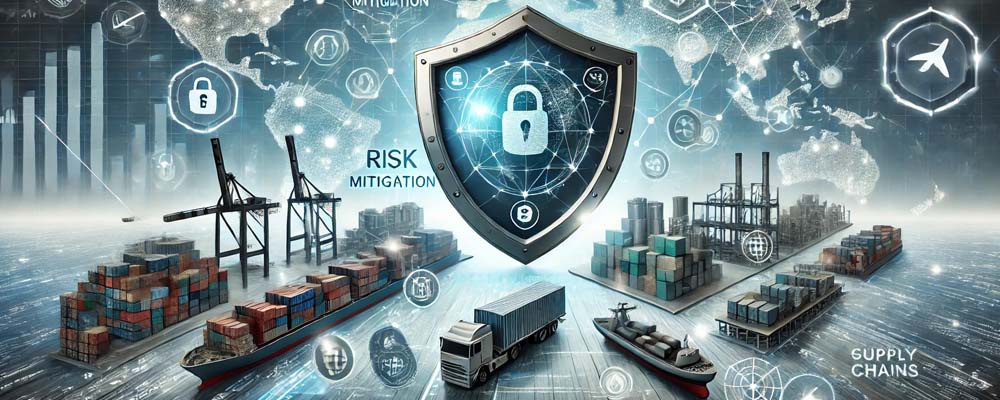
In today’s volatile global environment, supply chains face unprecedented challenges, ranging from geopolitical tensions and natural disasters to economic fluctuations and shifting consumer demand. This uncertainty has highlighted the importance of resilient supply chains—those that can adapt and continue to deliver products and services despite disruptions.
For freight forwarding companies, logistics providers, importers, exporters, customs brokers, manufacturers, and e-commerce businesses, building a resilient supply chain is not just a matter of operational efficiency but also a key competitive advantage. This article will explore the importance of resilient supply chains, the key factors that contribute to resilience, and best practices for risk mitigation and contingency planning. Additionally, we will examine how leveraging technology can enhance visibility and further strengthen supply chain resilience.
The Importance of Resilient Supply Chains
The ability of a supply chain to withstand disruptions and maintain operational continuity is crucial for any business operating in the global market. For companies involved in logistics and transportation, disruptions can lead to significant financial losses, damaged customer relationships, and eroded competitive positioning. Here’s why resilient supply chains are essential:
1. Risk Mitigation
Supply chain disruptions can come in many forms, including natural disasters, political instability, pandemics, and economic downturns. A resilient supply chain can help mitigate the impact of these disruptions by identifying vulnerabilities and preparing for alternative solutions. Businesses that proactively manage risks are better positioned to withstand challenges and reduce the financial and operational impact of unforeseen events.
2. Enhanced Customer Satisfaction
A supply chain that consistently delivers goods and services, even in the face of adversity, significantly improves customer satisfaction. Businesses that can keep their promises, no matter the external conditions, foster customer loyalty and increase their credibility in the marketplace. In industries such as e-commerce, where customer expectations for fast and reliable delivery are high, a resilient supply chain can set a business apart from its competitors.
3. Cost Savings
Although building a resilient supply chain requires upfront investment in risk management, contingency planning, and technology, it can lead to long-term cost savings. Proactively addressing potential vulnerabilities, diversifying suppliers, and having contingency plans in place can reduce the financial impact of disruptions. In contrast, businesses that reactively deal with disruptions often face higher costs, such as expedited shipping fees, loss of sales, or penalties for missed deadlines.
4. Competitive Advantage
Resilient supply chains enable businesses to adapt quickly to changing market conditions, providing a competitive edge. Whether it’s responding to shifts in consumer demand, changes in regulations, or external shocks like a global pandemic, businesses with robust supply chains can capitalize on opportunities and continue operations when competitors may be struggling.
 Best Practices for Risk Mitigation
Best Practices for Risk Mitigation
Creating a resilient supply chain begins with effective risk mitigation. Here are the key strategies to consider:
1. Risk Identification and Assessment
The first step in risk mitigation is identifying the potential risks that could disrupt the supply chain. These risks could include:
- Natural disasters (e.g., hurricanes, floods, earthquakes)
- Geopolitical events (e.g., trade wars, sanctions)
- Supplier failures (e.g., bankruptcy, labor strikes)
- Demand fluctuations (e.g., seasonal peaks, sudden drops in demand)
Once risks are identified, assess the likelihood and potential impact of each. This allows businesses to prioritize risk management efforts and allocate resources effectively.
2. Diversification
Relying on a single supplier or sourcing from one geographic region increases vulnerability. Diversifying the supply chain by working with multiple suppliers across different regions can mitigate the risk of disruption. For example, if one supplier is affected by a natural disaster, businesses can switch to alternative suppliers without significant downtime. Similarly, geographic diversification can reduce the impact of geopolitical events or regional issues.
3. Redundancy
Redundancy is about creating backups—whether it’s backup suppliers, additional inventory, or alternative transportation routes. While redundancy might seem costly, it provides crucial flexibility in times of crisis. For example, having multiple production facilities or warehouses across different locations ensures that operations can continue even if one facility is compromised.
4. Supplier Management
Establishing strong relationships with suppliers is critical for ensuring resilience. Regularly monitor supplier performance and maintain open lines of communication. This helps identify potential issues early and ensures that suppliers are meeting risk mitigation requirements. Conducting regular supplier audits can also be a useful strategy for ensuring that suppliers are prepared to handle disruptions.
Contingency Planning: Preparing for the Worst
Even the best risk mitigation strategies can’t prevent all disruptions, which is why contingency planning is essential. A comprehensive contingency plan ensures that businesses can maintain operations when disruptions occur.
1. Crisis Management Team
One of the first steps in contingency planning is establishing a cross-functional crisis management team. This team should include members from key departments such as logistics, procurement, operations, and customer service. The team’s role is to coordinate response efforts, communicate with stakeholders, and ensure business continuity during a disruption.
2. Communication Plan
Effective communication is critical during any disruption. A well-developed communication plan outlines how the business will communicate with customers, suppliers, employees, and other stakeholders. The plan should detail the communication channels (e.g., email, social media, press releases) and the messaging that will be used to keep stakeholders informed about the situation and the steps being taken to address it.
3. Business Continuity Plan
A business continuity plan outlines the actions necessary to keep essential operations running during a disruption. This includes identifying critical business functions, determining the resources needed to support those functions, and establishing procedures for maintaining operations during an interruption.
4. Disaster Recovery Plan
In the event of a major disaster, businesses need a plan to recover their operations and data. A disaster recovery plan outlines how the business will restore key systems and processes, including backup procedures for IT systems, data recovery protocols, and steps for resuming normal operations.
 Leveraging Technology to Enhance Supply Chain Visibility
Leveraging Technology to Enhance Supply Chain Visibility
In today’s digital age, technology plays a pivotal role in building resilient supply chains. With the right tools, businesses can gain real-time visibility into their supply chains, enabling them to identify potential issues before they escalate and respond quickly to disruptions.
1. Supply Chain Visibility Platforms
Supply chain visibility platforms provide businesses with real-time insights into the movement of goods and materials across the supply chain. These platforms track shipments, monitor inventory levels, and flag potential delays or issues. By having a clear view of the entire supply chain, businesses can make informed decisions and take proactive measures to mitigate disruptions.
2. Internet of Things (IoT)
The IoT has revolutionized supply chain management by providing real-time monitoring of assets and inventory. IoT sensors can be used to track shipments, monitor equipment performance, and detect potential issues like equipment failures or quality defects. For example, temperature sensors in refrigerated trucks can ensure that perishable goods are transported under the right conditions, reducing the risk of spoilage and waste.
3. Blockchain Technology
Blockchain technology can enhance supply chain transparency and traceability by providing a secure, decentralized record of transactions and events. This is particularly valuable in industries where verifying the origin and authenticity of products is critical, such as pharmaceuticals or food products. Blockchain reduces the risk of fraud, improves traceability, and ensures that all stakeholders in the supply chain have access to the same information.
4. Artificial Intelligence (AI)
AI has the potential to transform supply chain management by analyzing vast amounts of data and identifying patterns that may signal potential disruptions. AI-powered algorithms can predict demand fluctuations, optimize inventory levels, and improve transportation routes. Additionally, AI can help businesses make data-driven decisions in real time, enabling them to respond more effectively to changing conditions.
 Conclusion
Conclusion
In a world where uncertainty is the norm, building a resilient supply chain is no longer optional—it’s a necessity. For freight forwarders, logistics providers, manufacturers, importers, and exporters, resilience means not just surviving disruptions but thriving in the face of them. By adopting best practices for risk mitigation, developing robust contingency plans, and leveraging the latest technology, businesses can build supply chains that are both flexible and robust.
A resilient supply chain offers more than just operational continuity—it’s a strategic asset that can provide a significant competitive advantage. As the global landscape continues to evolve, businesses that invest in supply chain resilience will be better equipped to navigate the challenges ahead and seize opportunities in an increasingly unpredictable world.
With proactive planning and the right tools, businesses can turn supply chain disruptions from a threat into an opportunity for growth and innovation.




 Best Practices for Risk Mitigation
Best Practices for Risk Mitigation Leveraging Technology to Enhance Supply Chain Visibility
Leveraging Technology to Enhance Supply Chain Visibility Conclusion
Conclusion



